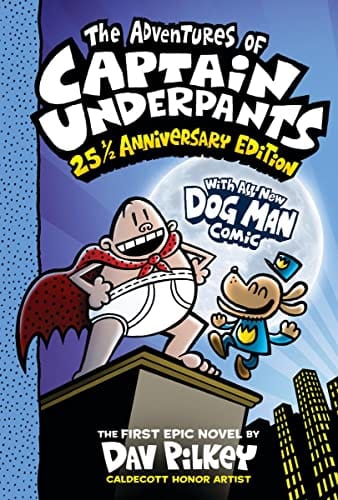Adventures of Captain Underpants: A Hilariously Heroic Book Review
Explore the hilarious world of Captain Underpants, its plot, characters, and educational value in an 800-word deep dive.

Introduction
Dav Pilkey’s “Adventures of Captain Underpants” has been yanking giggles out of young readers since its debut in 1997. The chapter book—bursting with flip-o-rama comic panels, mischievous pranks, and an unlikely underwear-clad hero—remains a gateway into independent reading for countless kids. Below, we explore the first book in the bestselling series, covering its plot, characters, themes, humor style, literary impact, and practical tips for parents and educators who may be wondering what all the belly laughs are about.
Who Is Captain Underpants?
Captain Underpants is the hypnotized alter ego of grumpy school principal Mr. Krupp, who is transformed by fourth-grade pranksters George Beard and Harold Hutchins. Sporting nothing but tighty-whiteys and a red cape fashioned from a curtain, the unlikely champion believes he has super strength, flight, and—most important—a sacred duty to fight injustice, particularly the injustice of boring school days. His cheery catchphrase, “Tra-la-laaa!” has become iconic in children’s pop culture.
Plot Overview
The inaugural book follows George and Harold, best friends who love drawing comics and pulling elaborate pranks at Jerome Horwitz Elementary. After they sabotage a football game with a cleverly deployed whoopee cushion stunt, Mr. Krupp catches them on surveillance video and blackmails the boys into servitude. Desperate, they purchase a 3-D Hypno-Ring from the back of a comic book, flip Mr. Krupp into a trance, and command him to act like Captain Underpants, the hero of their homemade comics. Chaos ensues when real villains appear, including Dr. Diaper and an army of talking toilets, forcing George and Harold to keep their hypnotized principal safe and the school out of total ruin.
Key Story Beats
1. The prank that starts it all: a bogus scoreboard and bubbles in the marching band’s instruments.
2. Mr. Krupp’s blackmail scheme and the power struggle between adult authority and kid creativity.
3. The fateful hypnotism that births Captain Underpants.
4. A rooftop battle featuring underpants‐flinging action scenes.
5. The accidental splash of water that turns Captain Underpants back into Mr. Krupp, setting up endless sequels.
Humor and Themes
Pilkey’s humor leans on slapstick, potty jokes, and exaggerated visuals, but underneath the silliness lie relatable themes: friendship, creativity, and the push-and-pull between conformity and freedom. George and Harold’s pranks symbolize youthful ingenuity—an affirmation that kids can outsmart rigid systems, albeit with fart powder and fake dog doo. The book also normalizes mistakes; every plan George and Harold hatch backfires in hilarious fashion, teaching resilience through comedic failure.
Visual Engagement
The signature flip-o-rama pages invite readers to flip two frames rapidly, creating a DIY animated fight sequence. This interactive element doesn’t just entertain; it helps reluctant readers experience page-turning momentum, forging a positive association with reading. Pilkey’s rough, sketchy line art echoes what a kid might draw in the margins of a math worksheet, reinforcing the empowering message that creativity trumps perfection.
Impact on Children’s Literature
“Adventures of Captain Underpants” arrived during a lull in humorous, illustrated fiction for middle-grade readers and paved the way for series like “Diary of a Wimpy Kid” and “Dog Man.” Pilkey’s fusion of comics and prose stretched the definition of a chapter book, encouraging publishers to experiment with hybrid formats. The series has sold over 80 million copies worldwide and has been translated into more than 25 languages, proving that toilet humor transcends borders.
Controversy and Censorship
Ironically, the same silly jokes that hook readers have landed the book on banned lists. Critics argue that the story promotes disrespect for authority and excessive bathroom humor. Supporters counter that the irreverence acts as a pressure valve for kids, offering a safe space to question rules and laugh at taboo topics. Research from literacy experts shows that when children pick their own funny books, reading motivation and comprehension both increase.
Why Kids Love It
Ask any eight-year-old and you’ll hear the same rave reviews: Captain Underpants is funny, fast, and full of pictures. The short chapters provide a sense of accomplishment, while the outrageous plot lets children momentarily escape homework doldrums. George and Harold feel like real kids—flawed but loyal—so readers identify with their urge to rebel against boring routines. Meanwhile, the danger stays cartoonish and nonthreatening, ensuring laughs outweigh fears.
Tips for Parents and Educators
• Embrace the humor: Reading together and laughing out loud turns the book into a shared experience rather than “just a fart joke.”
• Build vocabulary: Pause to discuss Pilkey’s playful words like “hypno-beam” or “boogerific.”
• Spark creativity: Encourage kids to create their own mini comics after finishing a chapter. This reinforces comprehension and narrative sequencing.
• Bridge to other books: Use the enthusiasm generated here to introduce graphic novels such as “Amulet” or nonfiction illustrated texts like “Science Comics.”
Conclusion
“Adventures of Captain Underpants” may not be highbrow literature, but its ability to ignite joy, creativity, and reading stamina in children is undeniably heroic. Beneath every wedgie joke lies a message about believing in your own imagination and challenging stale conventions. Whether you’re a parent fielding requests for more Captain Underpants books or an educator hunting for high-interest titles, Pilkey’s underdressed crusader is a safe bet for turning page-shy kids into lifelong readers. Tra-la-laaa, indeed!



